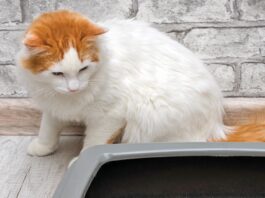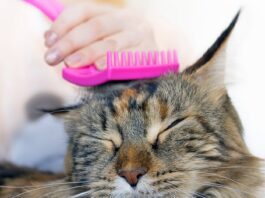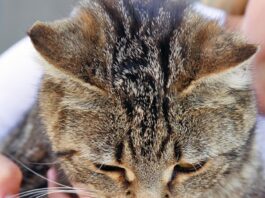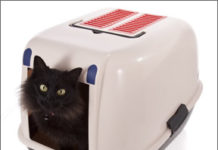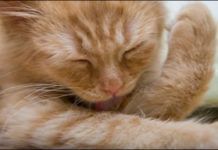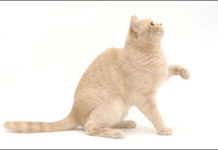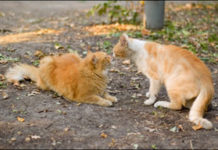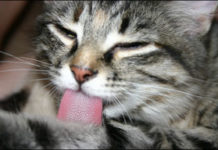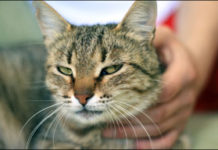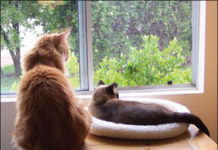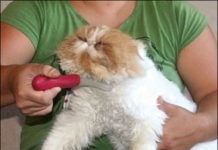Toxoplasmosis: The Facts
Toxoplasmosis is a fairly common zoonosis (a disease that can be shared between humans and animals); 30 to 40 percent of adult humans, and roughly the same percentage of cats, have antibodies that indicate prior exposure to the organism that causes the disease. Nevertheless, theres still a lot of misinformation regarding toxoplasmosis. The disease poses a threat primarily to fetuses and to immunosuppressed patients, but an understanding of the organisms life cycle, how transmission occurs and can be avoided, and the signs of infection can greatly reduce the risk of serious disease.
Keep Your Home Sweet Home
For all the companionship and love your cat brings into your home, theres also one dirty downside to living with him: the scooping and changing of his litter box (lugging home the heavy stuff isnt much of a treat, either). Luckily, there are ways of making this unpleasant job a little easier. If you use the right materials, create a litter-changing routine and keep the necessary supplies in a convenient place, this chore can definitely be made less labor-intensive. We share some tips to reduce litter drudgery.
The Danger of Hairballs
Every so often, your otherwise fastidious cat will do an alarming and somewhat disgusting thing. Shell awake from a peaceful nap, rise up on her paws, retch convulsively for a moment or two, and spit up what may appear at first glance to be a damp clump. What the animal has disgorged - in the middle of your kitchen floor or, worse yet, in the middle of your prized Persian rug - is a trichobezoar, a wad of undigested hair that is commonly referred to as a hairball. Despite the term, disgorged hairballs are not usually round. They are often slender and cylindrical, shaped more like a cigar or sausage than a ball. According to Richard Goldstein, DVM, an associate professor of small animal medicine at Cornell Universitys College of Veterinary Medicine, a spit-up hairballs elongated shape is imparted by the narrow food tube (esophagus) in which it develops or through which it passes on its journey from the cats stomach to the outside world. However, he notes, a hairball that is not disgorged and remains in the stomach will indeed be round - "like a sponge or a rolled-up sock," he says.
Popular Flea and Tick Products Now Available Over-the-Counter
According to Bayer Animal Health, Advantage and Advantix are now available over-the-counter. Formerly available only through veterinarians, these flea and tick products will now be sold at pet specialty retail and internet outlets.
Choosing an Alternative Litter
Over the past decade, numerous products have entered the cat litter market as "alternative" litters. The chief claim of many of these litters is that they are made from plant-based or recycled materials, as opposed to clay, the basis of "traditional" kitty litters. Potential Benefits. As with most products or groups of products, there are both advantages and disadvantages to using alternative cat litters. One advantage that makers of these specialty litters feel appeals to cat owners with environmental concerns is that alternative litters - because they are made of biodegradable substances - present less strain on landfills. Some brands are even marketed as being "compostable" and/or burnable. Additionally, alternative litters are made of materials that often give off little to no dust - which can be a benefit to a cat with upper respiratory issues. "Our general advice to owners of asthmatic cats is to limit environmental exposure to potential irritants of all kinds," says Carolyn McDaniel, VMD, a consultant with the Cornell Feline Health Center. "This includes aerosol cleaning agents, perfumes, cigarette smoke … and dusty cat litter."
Abscesses: Take Them Seriously
For several days, your cat has been acting uncharacteristically lethargic and off his food. Then one evening, while stroking his back, you feel a smallish lump just to the side of his tail. Although you touch the lump gently, he responds with a hiss, leaping from your lap and scurrying into a dark corner. The lump you discovered is quite possibly an abscess, and the sensitive swelling may indicate that the cat has an infection - and necessitating prompt veterinary care. Distinctive Characteristics. An abscess is a localized collection of pus, a yellowish fluid that forms at the site of an infection. Although pus typically contains a certain amount of cellular debris and dead tissue, it is composed mainly of white blood cells that have been summoned by the immune system to combat invading bacteria or other microorganisms. Cats can develop a variety of lumps and bumps on their skin - cysts, tumors, pimples and so forth - but abscesses have their own distinctive characteristics, notes William Miller, VMD, medical director at Cornell Universitys Companion Animal Hospital. "Because an abscess is filled with pus," he says, "it will be inflamed, warm and tender. Tumors are not usually like that, and pimples are merely superficial eruptions, affecting the outer layer of skin and minuscule by comparison to an abscess." External and Internal. An abscess may develop at the site of a penetrating wound - if a cat steps on a thorn, a wood sliver or a piece of glass, for example. But abscess-producing infections in cats usually result from bites from other cats, since the bacteria that cause infection are normal inhabitants of the feline mouth.
A Ban on Declawing?
The San Francisco Commission of Animal Control and Welfare wants the city to ban the declawing of cats. In a July hearing, the Commission voted 5 to 1 to recommend that the citys Board of Supervisors adopt an ordinance to ban the practice. (It would exclude cases where declawing is necessary for a cats health.) If passed, San Francisco will be the second city in the U.S. with such an ordinance. West Hollywood, CA, banned the practice in 2003.
Fur Changes Can Spell Trouble
One of your favorite things about your cat is her sleek, shining fur. Lately, though, it seems like your cat has been having a bad fur day - and she hasnt seemed very interested in grooming herself over the past week or so. Whats going on? "A decline in grooming or a change in the cats fur are some of the subtle signs that your cat may be ill," says Jane Brunt, DVM, of the Cat Hospital At Towson in Baltimore, Maryland. In fact, you can view your cats fur as a barometer of her overall health and well-being. If you do notice a change, report it to your veterinarian so that you can take steps to start treatment quickly. Ilness Indicator. One of the most common fur changes in cats is the loss of hair. You might notice clumps of fur coming out when you pet her, or her fur might just start to look patchy and scraggly. Causes for hair loss - called alopecia - include skin parasites (fleas and mites) and internal parasites (tapeworms or roundworms). These culprits indirectly rob your cats body of vital nutrients.
Ask Elizabeth: 09/09
My cat has just developed a black discharge in one ear. Ive never seen or heard of this kind of thing before. I have taken him to my veterinarian twice, and on each occasion, she cleaned the ear and microscopically examined the discharge. Im assured that there are no ear mites present. Whats the reason for the discharge and whats the prognosis?
A Health Checklist to Perform at Home
The owner is the veterinarians eyes and hands away from the office," explains Fred Scott, DVM, PhD, interim director of Cornells Feline Health Center. For this reason, it is important to be familiar with the steps involved in doing an at-home mini-physical examination on your cat. This should supplement your cats twice yearly trips to the veterinarian. Performing an at-home physical examination is much easier than you might think; in fact, Dr. Scott points out, the examination should be a normal extension of the regular attention you give your cat.
Ten Ways to Go Green
It should come as no surprise that Mother Nature is on the verge of taking a permanent sick day. After all, harmful climate changes due to greenhouse gases, air and water pollution, and the destruction of natural habitats are putting our planet and its inhabitants - both two- and four-legged - in peril. Hopefully, many of us have begun to make some changes in our daily lives to help reverse the damage done to, well, everything. But what role can our cats play in being good stewards of our beleaguered planet? There are many practical ways to reduce your felines carbon pawprint, which include switching to a corn or wheat-based cat litter and recycling cat food containers instead of throwing them in the trash. Get a jump start on Earth Day (April 22) by incorporating the following tips into your daily routine. Start out slowly if you wish by trying one or two new tips each week. Encourage your friends, family members and co-workers to join in your quest for a sustainable future. Youll find that its not only fun and easy to "go green," but youll see that you can make a positive and lasting impact on our world, which will please Mother Nature.
Help for the Matted Cat
While it may seem unlikely to you (given the reputation cats have for personal hygiene and grooming habits), a trip to the groomers can sometimes become necessary for a badly matted cat. There are several factors which can contribute to the matting of a cats haircoat, two ways to deal with it - and one simple way to avoid it in the future. Jana West, owner and operator of Shampooch, located in Savona, NY, has been grooming cats and dogs for eight years. West relates that the most common places for a cat to develop mats are on the back - near the tail, under the belly, along the hind legs and under the tail. She explains that there are three types of cats that [IMGCAP(1)]are more prone to developing mats in their haircoat: "The majority of the cats that have a problem are older cats, bigger cats or cats allowed to spend time outdoors." As cats age, grooming may become less important to them. In addition, cats with a weight issue may have more difficulty reaching certain areas of their bodies. And when it comes to outdoor cats, West adds, "Ideally, all cats would be kept inside and wouldnt come in contact with burrs and branches, but thats not always realistic."



